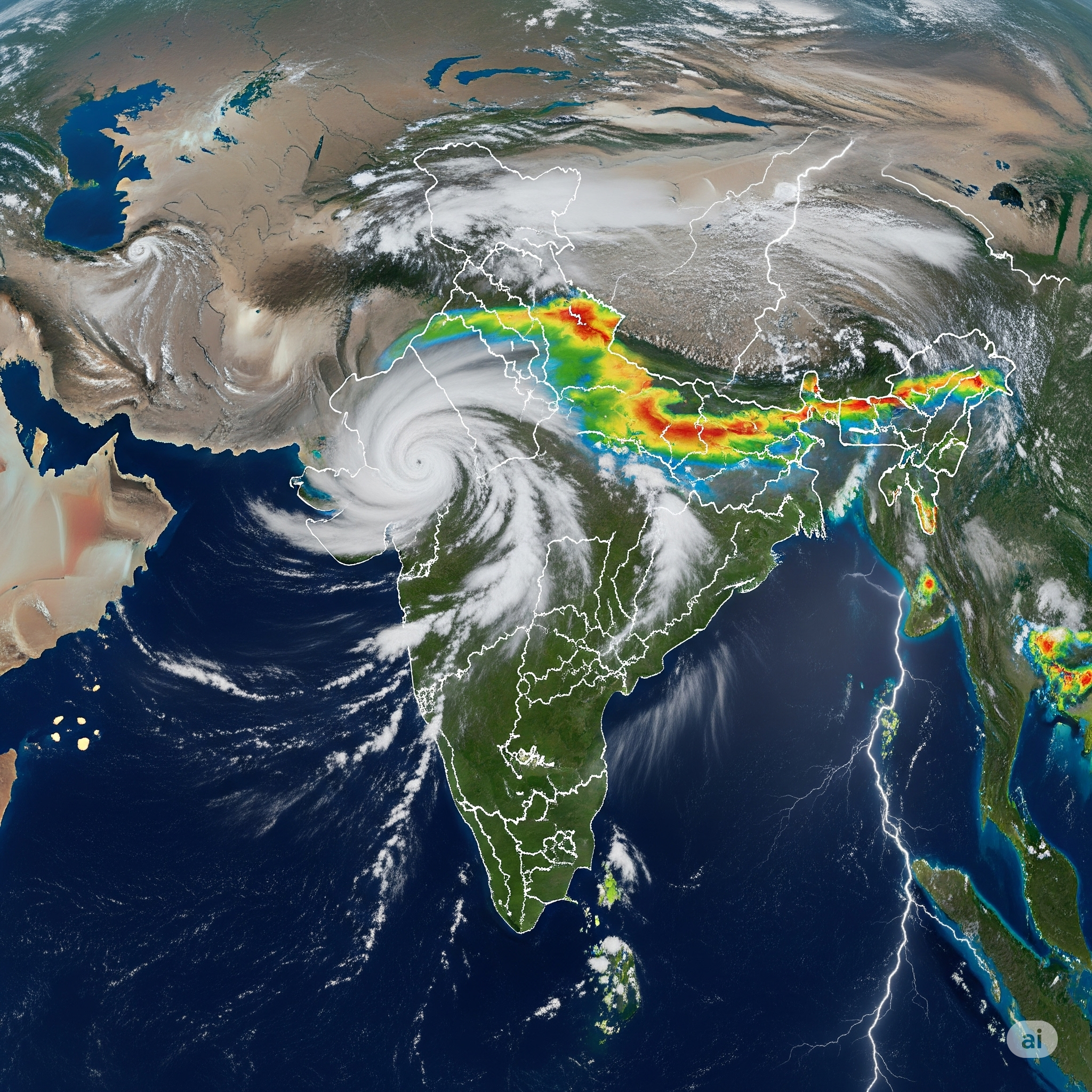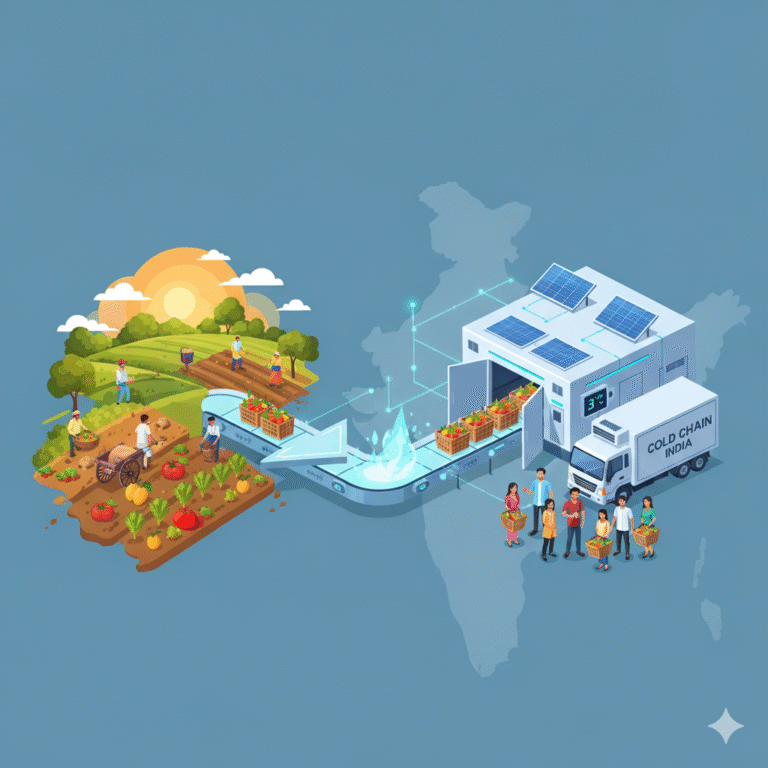š In-Short:
- Arabian Sea warming and weakened El NiƱo aided early monsoon
- MJO activity and weakened jet streams accelerated rainfall advancement
- Cyclone Remal and extreme land heating added further momentum
- Urban heat and topography enhanced local rainfall
- Early monsoons benefit agriculture but also raise flood risk
- Rising variability points toward climate-induced monsoon shifts
Monsoon Knocks EarlyāA Sign of Change?
In a surprising development, the India Meteorological Department (IMD) announced the earliest arrival of the southwest monsoon in North India since 2013, with regions like Punjab, Jammu & Kashmir, Himachal Pradesh, Ladakh, and Delhi witnessing pre-scheduled rainfalls. The monsoonās arrival in Delhi, which usually happens between June 27 and July 1, is now several days early, triggering curiosity among citizens, scientists, and policymakers alike.
But why did the monsoon arrive early in India this year? What climatic systems were at play? Is this an anomaly or part of a broader climate trend? This article explores the scientific, oceanic, atmospheric, and anthropogenic factors that led to the early onset of monsoon in 2025āand what this could mean for the future.
š 1. What Is the Indian Monsoon and Why Does Its Timing Matter?
1.1 The Monsoon System in Brief
The Indian summer monsoon is a complex atmospheric circulation system that dominates the subcontinentās weather between June and September. It is responsible for:
- 80% of India’s annual rainfall
- Sustaining agriculture for over 50% of the population
- Refilling reservoirs and aquifers essential for water security
The monsoon typically starts over Kerala in early June and progresses northward. A timely monsoon is crucial for optimal kharif crop sowing, rural employment, and hydropower generation.
1.2 Monsoon Onset and Withdrawal
Monsoon onset is declared based on:
- Precipitation thresholds over a set period
- Wind pattern shifts to southwesterlies
- Increased humidity and cloud cover
In 2025, IMD noted the fulfillment of all conditions much earlier than expected, especially over the northwest and Indo-Gangetic plains.
š 2. Oceanic Drivers Behind the Early Monsoon
2.1 Arabian Sea Surface Temperatures (SSTs)
The Arabian Sea recorded higher-than-normal SSTs (~1ā2Ā°C above average) in late May and early June. Warmer waters lead to:
- Increased evaporation and moisture-laden winds
- Stronger low-pressure systems, especially near the Konkan coast
- Faster propagation of the monsoon trough into central and northern India
2.2 Weaker El NiƱo Influence
El NiƱo, the warming of the equatorial Pacific, often delays or weakens Indian monsoons. However:
- The 2023ā24 El NiƱo event weakened significantly by April 2025
- Ocean-atmosphere models suggest a shift toward a Neutral or early La NiƱa state
- This transition allowed normal to stronger cross-equatorial flows from the Indian Ocean, helping early monsoon advancement
š¬ļø 3. Atmospheric & Synoptic Factors
3.1 Madden-Julian Oscillation (MJO) Activation
The Madden-Julian Oscillation (MJO) is a large-scale tropical disturbance that moves eastward across the Indian and Pacific Oceans. In 2025:
- The MJO was in its active phase over the Indian Ocean in early June
- This promoted convection and the formation of monsoon-friendly systems
3.2 Jet Stream Weakening
The subtropical westerly jet stream, which usually suppresses monsoon advancement, was unusually weak this season. This allowed:
- A northward shift of the Inter-Tropical Convergence Zone (ITCZ)
- Reduced shearing effects over the Indian landmass
- Smoother northward monsoon progression
š 4. The Role of Pre-Monsoon Cyclones
India witnessed Cyclone Remal in the Bay of Bengal just weeks before the monsoon onset. While it made landfall in Bangladesh, its remnant moisture and pressure systems helped:
- Enhance low-level wind circulation across eastern and central India
- Push monsoon currents deeper inland
- Trigger early rainfall episodes in northeastern and eastern India
Such pre-monsoon cyclones are known to prime the atmosphere for faster monsoon establishment, especially when followed by favorable wind patterns.
š”ļø 5. Rising Land Temperatures Accelerate the Process
AprilāJune 2025 recorded exceptionally high temperatures in northern and central India, with Delhi, Rajasthan, and Uttar Pradesh witnessing:
- Temperatures consistently above 45ā47Ā°C
- Increased thermal contrast between land and ocean
- Faster development of thermal lows, which helped pull moist air from the Arabian Sea inland
This land-ocean heat contrast is a key driver of monsoon onset speed and strength, especially across the Indo-Gangetic plains.
šļø 6. Urban & Topographic Influences
Although natural factors dominate monsoon dynamics, urban heat islands, especially in mega cities like Delhi and Lucknow, created localized convective hotspots that enhanced:
- Early pre-monsoon showers
- Thunderstorms aiding cloud formation
- Faster regional convergence of moist air masses
In hilly regions like Himachal Pradesh and Uttarakhand, the orographic uplift (mountains forcing air to rise) further intensified early rains.
š 7. Climate Change: A Broader Context
7.1 Rising Variability
Climatologists argue that the early monsoon onset aligns with:
- Increased variability in seasonal patterns
- Higher frequency of extreme rainfall events
- Shorter but intense rainfall periods
7.2 IMDās Evolving Prediction Models
The IMDās dynamic prediction model (Monsoon Mission) now incorporates:
- Coupled Ocean-Atmosphere data
- Machine learning models
- Inputs from NOAA, ECMWF, and IITM Pune
In 2025, these tools enabled a more accurate monsoon forecast, allowing for better early warnings to farmers and disaster agencies.
š¾ 8. What This Means for India: Short-Term and Long-Term
8.1 Immediate Relief from Heat
For millions suffering under a punishing heatwave, early monsoon arrival:
- Reduces heatstroke risks
- Restores crop sowing windows
- Eases power grid demand for cooling
8.2 Good News for Farmers (If Rains Sustain)
- Early monsoon supports timely Kharif sowing
- Lowers dependency on tube wells, saving diesel
- Helps maintain soil moisture balance for rainfed crops
However, early arrival does not guarantee uniform distribution. Too much rain in a short span can damage saplings, flood lowlands, or delay transplantation.
8.3 Urban Challenges and Flood Risk
- Urban areas like Delhi, Chandigarh, and Patna may face drainage failure due to unprepared infrastructure
- Flash floods, waterlogging, and vector-borne disease outbreaks are likely if rain intensity remains high
ā Conclusion: Natureās Surprise, Scienceās Challenge
The early arrival of the monsoon in India in 2025 is a classic example of how multiple atmospheric and oceanic systems interact, sometimes unpredictably. While it brings short-term relief and potential agricultural benefits, it also raises questions about long-term monsoon stability, preparedness, and climate resilience.
India must now move beyond forecasting to better adaptation and infrastructure, ensuring that every drop of early rain becomes a boonānot a burden.








+ There are no comments
Add yours